.
FRANCE 2012
Day 10, Sept 12
Clermont- Avignon
After a delicious breakfast, we left Alain and Mariecke’s home about
10:00 and headed south. The road from the outskirts of Clermont began
getting narrower and narrower and very curvy, up and down hill. The GPS
said that we were on the right road. Eventually we got on a better two
lane road which went through a lot of small villages - we heard the
mooing in the car (we have our GPS set so that there is a cow mooing
sound if we go over the speed limit) several times. The amazing thing
about these little towns is that you never see anyone. All of the
houses are right on the road but there are never any people. It began
to rain. It rained heavily off and on with some fog.
It took us 2 hours to get to Le Puy en Velay. It is a city of
about 21,000 people in the Auvergne region of South Central France.
There was a lot of traffic in the town. There are three very interesting “attractions” in Le Puy- the
cathedral, a huge statue of Mary, and St. Michael’s chapel. They are
built on top of a volcanic dolomite or pillar.
Our trusty TomTom had the directions to the cathedral so we went up
hill on some extremely narrow streets.  We turned left and went a few
feet to find the remainder of the street torn up. We had to back out on
to the little busy street that we had just left. It was quite an
adventure. We were having very little success getting close to where we
wanted to go. We saw a sign for Office of Tourism and headed towards
it. The rain was beginning to slacken. We found a parking place and
went to the office. They said it was about a 7 minute walk up the
hill. It was noon, and we were hungry. Next to the tourist office was
a nice little restaurant – when I say "little" - it had only four
tables. I was very beautifully appointed. I had gnocchi on a thin
piece of ham with a delicious mushroom sauce. Kathleen had a wonderful
omelete. Most of the places, we have eaten have been very small but had
excellent food.
We turned left and went a few
feet to find the remainder of the street torn up. We had to back out on
to the little busy street that we had just left. It was quite an
adventure. We were having very little success getting close to where we
wanted to go. We saw a sign for Office of Tourism and headed towards
it. The rain was beginning to slacken. We found a parking place and
went to the office. They said it was about a 7 minute walk up the
hill. It was noon, and we were hungry. Next to the tourist office was
a nice little restaurant – when I say "little" - it had only four
tables. I was very beautifully appointed. I had gnocchi on a thin
piece of ham with a delicious mushroom sauce. Kathleen had a wonderful
omelete. Most of the places, we have eaten have been very small but had
excellent food.
Le Puy has been a religious center since ancient times, thanks
in part to its mystical landscape of volcanic pinnacles. The city
itself owes its existence to the cathedral on the hill consecrated to
the Virgin Mary, while the rock needle just outside of town was
consecrated to the Roman god Mercury before being dedicated to St.
Michael the Archangel. Since the Middle Ages Le Puy has been a major
place of pilgrimage in its own right (Charlemagne visited twice) as well
as a starting point of pilgrimages to Santiago de Compostela. Pilgrims
are still blessed in the Cathedral every morning at 7 AM before they set
off on their journey.
According to an interesting legend dating from the 8 century,
a woman in Le Puy, suffering from a fever in the first century, was
inspired by a vision to visit the rock on which the Cathedral now
stands. There she fell into a feverish sleep. When she awoke her fever
was gone, and she saw the Virgin Mary sitting on a dolmen next to her.
The Virgin said she wanted the church to be built in that place.
Although it was July, several inches of snow covered the ground, and a
stag marked out the floor plan of a huge church with its hooves.
St. George was then the Bishop of Le Puy, and he came to see
the miracle for himself. He wished to obey the Virgin's request, but he
has no money for such a grand church. So he decided to plant a thorn
hedge over the ground plan until such funding could be found. The next
day, the hedge bloom with flowers.
Some time pasted and another healing occurred. The Bishop (now a man
named Vozy) therefore went to Rome to ask for permission to build a
Cathedral on the site. It was granted, and the Pope provided a Roman
architect to build it. When it was completed, the Bishop set out for
Rome again to arrange its consecration, but two old man appeared to him
on the way and said quote "we shall go before you and take charge of
all". Returning to the Cathedral, Bishop Vozy founded it bathed in
strange light, it's bells ringing by unseen hands.
LE PUY CATHEDRAL
The Rock on which the Cathedral stands, and known as Mount Anis or
Corneilie Rock, was originally a Celtic and then a Roman pagan site. The
dolmen that figures in early Christian legend i s a remnant of the
ancient pagan shrine. A Roman temple was built there in the first
century A.D., dedicated to a local God at Adido and the Emperor
Augustus. Built near a sacred spring, it incorporated the dolmen. This
Temple was destroyed in the early 400sn by order of the Christian Roman
emperors.
s a remnant of the
ancient pagan shrine. A Roman temple was built there in the first
century A.D., dedicated to a local God at Adido and the Emperor
Augustus. Built near a sacred spring, it incorporated the dolmen. This
Temple was destroyed in the early 400sn by order of the Christian Roman
emperors.
The first Cathedral on Mount Anis was begun in 415 A.D. by
Bishop Scutarius of Le Puy. The Bishop was clearly a strong believer in
the power of the dolmen, for he incorporated in his Cathedral at a time
when toleration of paganism meant immediately excommunication Bishop
Scutarius build his church on the ruins of the Roman temple,
incorporating some of its masonry. The church had a single nave of two
bays and measured 40 x 80'. The side aisles were added in the 6 century,
using ancient Roman tombstones in the walls. Bishop Scutarius tomb is
in the south aisle. To accommodate increasing number of pilgrims, the
Cathedral was lengthened to the West by a third Bay some time before
1000 A.D. and a fourth bay was added in the 11th century. Finally in the
12th century the last two Western bays were added. A major restoration
was carried out in the 19th century.
It had stopped raining so we hiked up the hill There are
 134 steps
up to the Cathedral and they run right through the floor and come out at
the altar. It is hard to describe what it felt like to stand at the
bottom of the hill and look up, see the tiny set of steps, and know that
if you wanted to see the Cathedral, you had to walk up. There is
supposed to be a back entrance where you don’t have to climb all those
steps but we couldn’t find it. We, with bad knees and hips, decided to
do it. Most of the way did not have hand rails, but we made it.
134 steps
up to the Cathedral and they run right through the floor and come out at
the altar. It is hard to describe what it felt like to stand at the
bottom of the hill and look up, see the tiny set of steps, and know that
if you wanted to see the Cathedral, you had to walk up. There is
supposed to be a back entrance where you don’t have to climb all those
steps but we couldn’t find it. We, with bad knees and hips, decided to
do it. Most of the way did not have hand rails, but we made it.
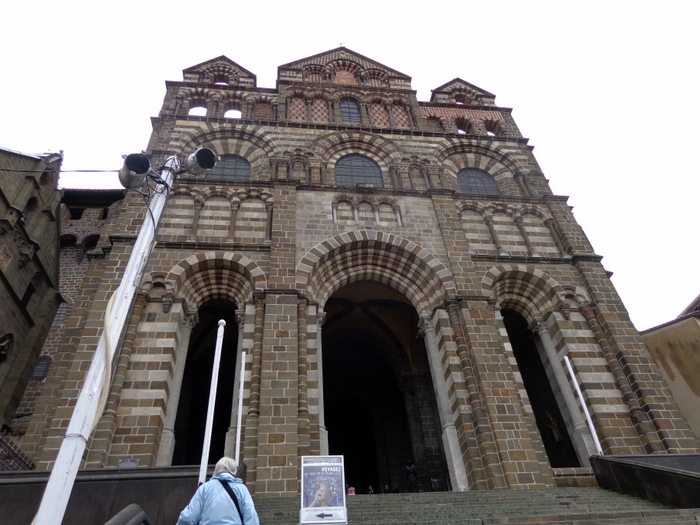 The façade of the Cathedral is divided into three parts both
horizontally and vertically, is black and gray volcanic stone is
enriched by striped arches and mosaic decorations at the top. It has
three tall open portals which leads into a very large porch. The center
portal contains the famed Cedar Doors, which despite their name are
carved of pinewood. These doors from the 12th century shows strong Arab
influence, which would have been derived from both contact with Muslim
Spain and the Crusades.
The façade of the Cathedral is divided into three parts both
horizontally and vertically, is black and gray volcanic stone is
enriched by striped arches and mosaic decorations at the top. It has
three tall open portals which leads into a very large porch. The center
portal contains the famed Cedar Doors, which despite their name are
carved of pinewood. These doors from the 12th century shows strong Arab
influence, which would have been derived from both contact with Muslim
Spain and the Crusades.
In everything that we read about this cathedral,
before
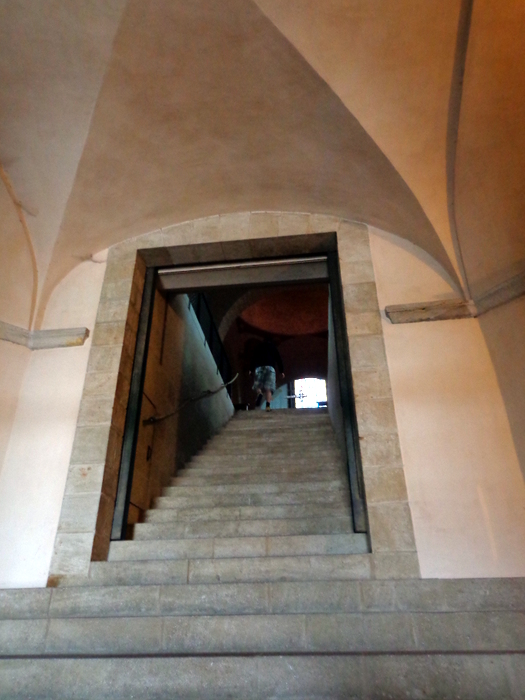 and after our visit, it was noted that in the middle ages the
stairway continued all the way to the middle of the nave, emerging in
front of the choir screen. Of this unusual arrangement a friar famously
commented, "you use to enter the church of our Lady through the naval
and come out through ears". Everything that I read about s
and after our visit, it was noted that in the middle ages the
stairway continued all the way to the middle of the nave, emerging in
front of the choir screen. Of this unusual arrangement a friar famously
commented, "you use to enter the church of our Lady through the naval
and come out through ears". Everything that I read about s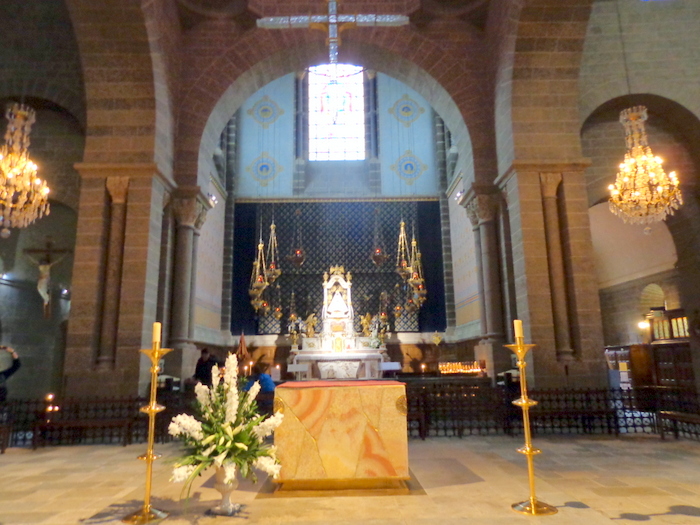 aid that
the layout was changed in 1781 when central stairway was walled up and a
right hand stairway was adapted to lead to the south aisle. Sometime in
recent years this wall was removed and the stairway continued through
the floor ending in front of the altar as it originally did. We enjoyed
seeing this feature.
aid that
the layout was changed in 1781 when central stairway was walled up and a
right hand stairway was adapted to lead to the south aisle. Sometime in
recent years this wall was removed and the stairway continued through
the floor ending in front of the altar as it originally did. We enjoyed
seeing this feature.
The Le Puy Cathedral has a simple floor plan of a Latin cross, with
three aisles and a transept the nave ceiling, which has six large
cupolas instead of the usual vault this is an example of strong
Byzantine influence. The cupola owes rest on octagonal bases made of
striped arches. Please have a look at my model of Le Puy Cathedral.
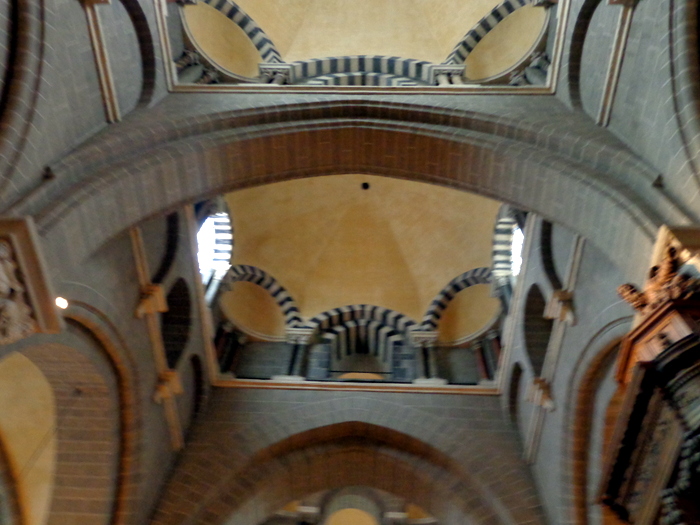
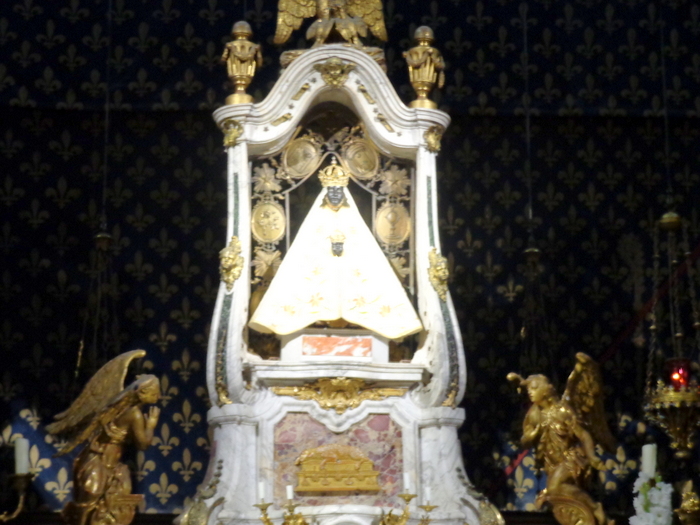
The altar has 18th-century bronze statues and the 18th-century copy
of the famous black Virgin.
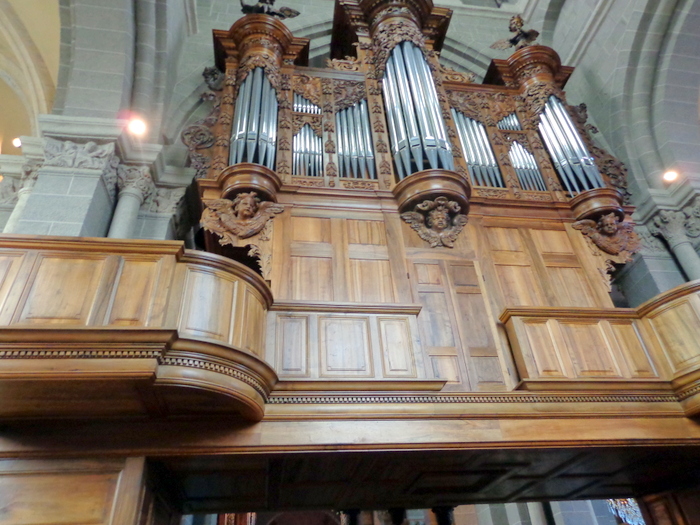
About three fourths of the distance to the
West wall was a huge pipe organ.

We
had hoped to find alternate way to our car, but had to climb down all of
those steps, which was "great fun".
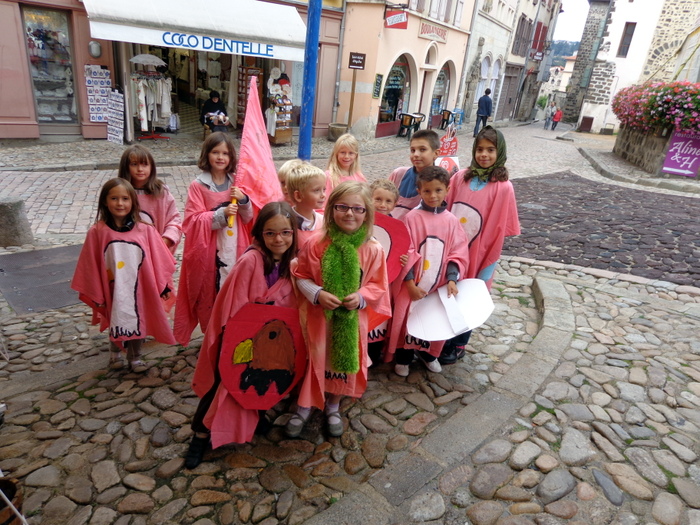 We spent about 45 minutes and walked down again. At the bottom of
the hill we saw a small group of schoolchildren dressed in pink robes
with animal heads on their shields. We took a number of pictures of
them.
We spent about 45 minutes and walked down again. At the bottom of
the hill we saw a small group of schoolchildren dressed in pink robes
with animal heads on their shields. We took a number of pictures of
them.
Further down the hill we ran into another group of children in
costume.
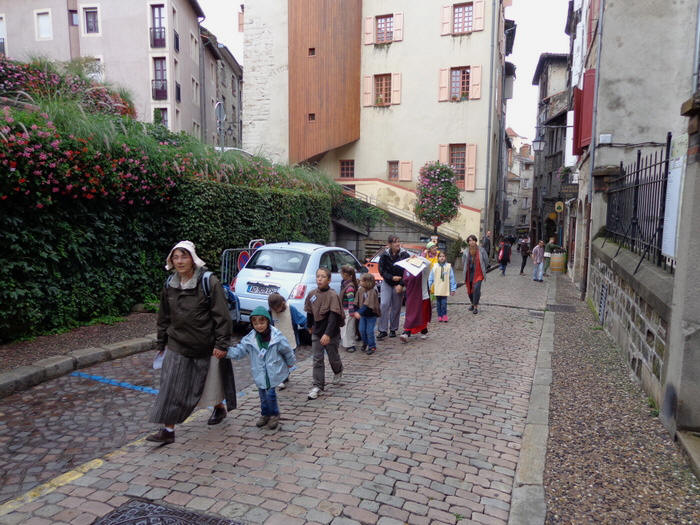
 We
had not seen any evidence of restrooms, but were amused with a sign
indicating a dog WC
We
had not seen any evidence of restrooms, but were amused with a sign
indicating a dog WC
We were watching our time and knew that we had four more hours
driving before reaching Avignon so we left about 3:00 and didn’t get to
see the statue or the chapel which had about 300 steps up to it.

It started to rain again, and we were still on little two lane
roads. All of sudden we saw a road sign for a 10% grade – what a grade
it was! - down and down and around and round on the side of a mountain
for many, many miles. I have driven nothing like it before even the
mountains of West Virginia seem like little hills.
We finally reached Avignon at 7:00 p.m. and checked into o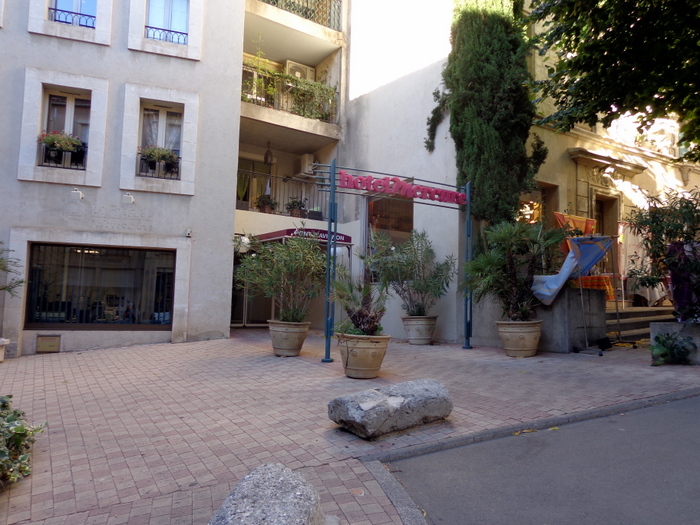 ur hotel.
It is rather new and is part of the Mercure chain. We have a huge
bedroom and a separate sitting room. Our room is on the corner and out
one window we can see part of the Palace of Popes and out the other
window w
ur hotel.
It is rather new and is part of the Mercure chain. We have a huge
bedroom and a separate sitting room. Our room is on the corner and out
one window we can see part of the Palace of Popes and out the other
window w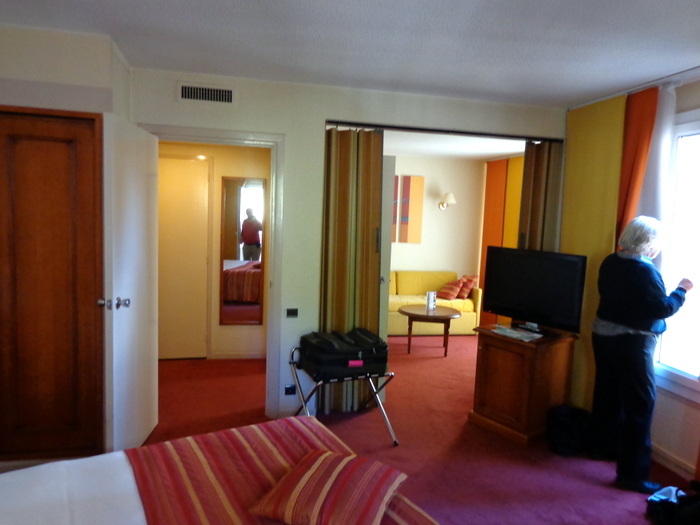 e can see the arch before the famous bridge Pont d’Avignon.
e can see the arch before the famous bridge Pont d’Avignon.
We had an 8:00 dinner reservation in a well known and highly
recommended restaurant - Fou de FaFa. It was about a 10 minute walk
through the old city. Again it was a very small restaurant with only 9
tables – only 2 of the tables for 4. We have had our reservations for
months. They kept turning people away. The restaurant is owned by a
young couple from England. We had a delicious meal. I began with a
chicken liver pate and Kathleen had goat cheese. We both had fish. The
dinner was beautifully presented and very delicious. I had a tiramisu
for dessert and Kathleen had sorbets. It all took a very long time.
People in Europe are in no hurry to eat and meals go on for hours. If
you ate two big meals a day that would be all you would get done.
It had been a long day of driving with some bad weather so we were
ready for bed.

 We turned left and went a few
feet to find the remainder of the street torn up. We had to back out on
to the little busy street that we had just left. It was quite an
adventure. We were having very little success getting close to where we
wanted to go. We saw a sign for Office of Tourism and headed towards
it. The rain was beginning to slacken. We found a parking place and
went to the office. They said it was about a 7 minute walk up the
hill. It was noon, and we were hungry. Next to the tourist office was
a nice little restaurant – when I say "little" - it had only four
tables. I was very beautifully appointed. I had gnocchi on a thin
piece of ham with a delicious mushroom sauce. Kathleen had a wonderful
omelete. Most of the places, we have eaten have been very small but had
excellent food.
We turned left and went a few
feet to find the remainder of the street torn up. We had to back out on
to the little busy street that we had just left. It was quite an
adventure. We were having very little success getting close to where we
wanted to go. We saw a sign for Office of Tourism and headed towards
it. The rain was beginning to slacken. We found a parking place and
went to the office. They said it was about a 7 minute walk up the
hill. It was noon, and we were hungry. Next to the tourist office was
a nice little restaurant – when I say "little" - it had only four
tables. I was very beautifully appointed. I had gnocchi on a thin
piece of ham with a delicious mushroom sauce. Kathleen had a wonderful
omelete. Most of the places, we have eaten have been very small but had
excellent food. s a remnant of the
ancient pagan shrine. A Roman temple was built there in the first
century A.D., dedicated to a local God at Adido and the Emperor
Augustus. Built near a sacred spring, it incorporated the dolmen. This
Temple was destroyed in the early 400sn by order of the Christian Roman
emperors.
s a remnant of the
ancient pagan shrine. A Roman temple was built there in the first
century A.D., dedicated to a local God at Adido and the Emperor
Augustus. Built near a sacred spring, it incorporated the dolmen. This
Temple was destroyed in the early 400sn by order of the Christian Roman
emperors.  134 steps
up to the Cathedral and they run right through the floor and come out at
the altar. It is hard to describe what it felt like to stand at the
bottom of the hill and look up, see the tiny set of steps, and know that
if you wanted to see the Cathedral, you had to walk up. There is
supposed to be a back entrance where you don’t have to climb all those
steps but we couldn’t find it. We, with bad knees and hips, decided to
do it. Most of the way did not have hand rails, but we made it.
134 steps
up to the Cathedral and they run right through the floor and come out at
the altar. It is hard to describe what it felt like to stand at the
bottom of the hill and look up, see the tiny set of steps, and know that
if you wanted to see the Cathedral, you had to walk up. There is
supposed to be a back entrance where you don’t have to climb all those
steps but we couldn’t find it. We, with bad knees and hips, decided to
do it. Most of the way did not have hand rails, but we made it.
 The façade of the Cathedral is divided into three parts both
horizontally and vertically, is black and gray volcanic stone is
enriched by striped arches and mosaic decorations at the top. It has
three tall open portals which leads into a very large porch. The center
portal contains the famed Cedar Doors, which despite their name are
carved of pinewood. These doors from the 12th century shows strong Arab
influence, which would have been derived from both contact with Muslim
Spain and the Crusades.
The façade of the Cathedral is divided into three parts both
horizontally and vertically, is black and gray volcanic stone is
enriched by striped arches and mosaic decorations at the top. It has
three tall open portals which leads into a very large porch. The center
portal contains the famed Cedar Doors, which despite their name are
carved of pinewood. These doors from the 12th century shows strong Arab
influence, which would have been derived from both contact with Muslim
Spain and the Crusades.  and after our visit, it was noted that in the middle ages the
stairway continued all the way to the middle of the nave, emerging in
front of the choir screen. Of this unusual arrangement a friar famously
commented, "you use to enter the church of our Lady through the naval
and come out through ears". Everything that I read about s
and after our visit, it was noted that in the middle ages the
stairway continued all the way to the middle of the nave, emerging in
front of the choir screen. Of this unusual arrangement a friar famously
commented, "you use to enter the church of our Lady through the naval
and come out through ears". Everything that I read about s aid that
the layout was changed in 1781 when central stairway was walled up and a
right hand stairway was adapted to lead to the south aisle. Sometime in
recent years this wall was removed and the stairway continued through
the floor ending in front of the altar as it originally did. We enjoyed
seeing this feature.
aid that
the layout was changed in 1781 when central stairway was walled up and a
right hand stairway was adapted to lead to the south aisle. Sometime in
recent years this wall was removed and the stairway continued through
the floor ending in front of the altar as it originally did. We enjoyed
seeing this feature. 
 We spent about 45 minutes and walked down again. At the bottom of
the hill we saw a small group of schoolchildren dressed in pink robes
with animal heads on their shields. We took a number of pictures of
them.
We spent about 45 minutes and walked down again. At the bottom of
the hill we saw a small group of schoolchildren dressed in pink robes
with animal heads on their shields. We took a number of pictures of
them. 
 We
had not seen any evidence of restrooms, but were amused with a sign
indicating a dog WC
We
had not seen any evidence of restrooms, but were amused with a sign
indicating a dog WC ur hotel.
It is rather new and is part of the Mercure chain. We have a huge
bedroom and a separate sitting room. Our room is on the corner and out
one window we can see part of the Palace of Popes and out the other
window w
ur hotel.
It is rather new and is part of the Mercure chain. We have a huge
bedroom and a separate sitting room. Our room is on the corner and out
one window we can see part of the Palace of Popes and out the other
window w e can see the arch before the famous bridge Pont d’Avignon.
e can see the arch before the famous bridge Pont d’Avignon.
